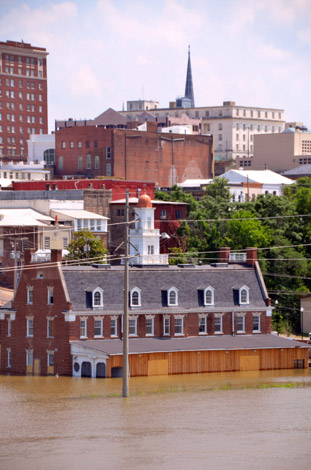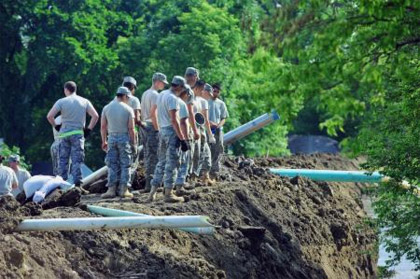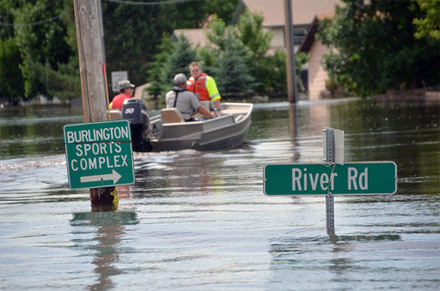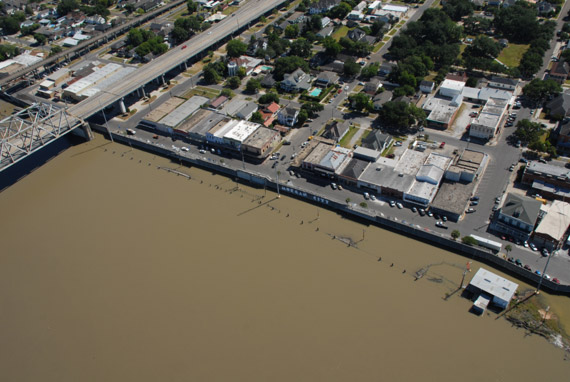USACE Institute for Water Resources: Adapting to Climate & Global Change
Major 21st Century global challenges, alone and in combination, affect parts of all missions and operations carried out by the U.S. Army Corps of Engineers (USACE). These dynamic global and local transformations include changing demographics and population growth rates, varying land use/land cover types, decaying and aging infrastructure, continuing global conflicts, declining biodiversity, increasing globalization pressures, altering social values and economic conditions, and transitioning climate. Any of these changes can occur abruptly and often are linked together, as the global 2008 economic crisis has shown.
Because Earth is a dynamic and complex physical system interconnected in complex ways, these global changes will often interact and combine in unpredictable ways. Those combinations then can result in surprising or very abrupt changes that threaten public health and safety or performance of built water resources infrastructure and functioning of ecosystems on which human society depends. An example is the combination of weakened Florida Current Transport, persistent northeasterly winds, and the perigean-spring tide (an extreme predicted tide when the moon is closest to Earth during a spring tide). None of these is highly unusual or enough to cause flooding on its own, but the combination caused lowland flooding along the mid-Atlantic coast in June and July 20091.
Water resources infrastructure represents a tremendous Federal investment that supports public safety and local and national economic growth. USACE has the responsibility to characterize and understand potential threats to its missions, operations, programs and projects from these global changes and their interactions. It also has the responsibility to engineer and to deploy adaptation strategies and policies, which reduce these threats where they are expected to appear. Because global changes can result in regional and local impacts to performance or reliability of national water resources projects and project systems, design, engineering and response management must take into account a wide range of potential future conditions.
One global alteration challenging USACE is changing climate. Variable weather is not new. Earth’s climate is naturally shaped by many different inputs, which are themselves changing over time. Extensive records from ice cores, tree rings, sediment cores, glacier lengths and other sources (summarized in a 2006 National Research Council report2) demonstrate climate’s changing nature and the range of previous variability. This long record also makes clear that these changes have occurred both gradually and abruptly (summarized in another National Research Council report3), and have different effects in different locations.

USACE photo
The best available scientific evidence, based on observations from long-term monitoring networks, shows that for some of the measured network indicators global climate is now changing at rates or in ways outside the ranges seen in our observed or long-term records. Additionally, effects of these changes are different in different regions4. Statistically significant variability in regional and local high and low temperatures, for example, and in the form, frequency and duration of precipitation, and the timing of snowmelt, have been carefully documented throughout the United States. More changes like these are projected for the future. These variations are important to USACE because they can affect seasonal and spatial water distribution, causing, in extreme cases, both floods and droughts.
The changing seasonal, spatial and extreme ranges of water quantity stress the Nation’s ability to manage its water resources. For example, in 2011 the United States experienced major, in some cases unprecedented, flooding of the northern Red River, Souris, Ohio, Mississippi and Missouri river basins while nearly one-half the country was simultaneously experiencing extreme or exceptional drought.5 Some USACE projects faced drought and floods at the same time. In one case, heavy precipitation in April 2011 dropped more than 10 inches of rain on the Tulsa District’s Tenkiller Ferry Lake watershed in eastern Oklahoma. This resulted in the highest stage since the dam was put into service 60 years ago. But, because Tenkiller Ferry Lake was already below normal pool levels when the flood occurred, due to lingering winter-time drought conditions, sufficient storage was available for water managers to maintain safe operations.
The built infrastructure, which helps to manage these extreme hydrologic effects, is intentionally designed to reduce threats of too much or too little water in regional and local areas. In addition, it has been engineered to work through a defined range of climate-driven variability in local and regional hydrology. Now, however, climate appears to be changing at rates and in places different from what can be seen in physical climate records. This means, in order to continue to meet its mission objectives to the Nation, USACE must consider these additional climate changes when planning strategies and policies. It must now adapt projects and programs, where required and within authorizations, to enhance resilience against potential climate threats to its missions and objectives. Just as USACE adapts to other changes – such as constrained future budgets – it must also develop adaptation strategies and policies to manage its responses to changed hydrologic extremes in order to reduce the Nation’s potential vulnerabilities to climate-forced threats.
USACE began work to understand and to adapt its projects, programs, operations and missions to global and climate change impacts shortly after Hurricane Katrina. This occurred when internal and external reports demonstrated a need to incorporate new and changing information. The USACE goal is to develop practical, nationally consistent and regionally tailored, legally justifiable and cost-effective adaptation measures, both structural and nonstructural, that will reduce vulnerabilities and improve resilience to these new challenges.
USACE submitted its “Climate Change Adaptation Plan and Report 2011” to the White House Council on Environmental Quality (CEQ) this past June6. This report contains information requested by CEQ and the Office of Management and Budget (OMB) in their March 4, 2011 document, “Implementing Instructions for Federal Agency Climate Change Adaptation7.” It includes the official USACE policy statement on climate change adaptation signed by Jo-Ellen Darcy, Assistant Secretary of the Army for Civil Works, which calls for integrating climate change adaptation into everything USACE does.
“Mainstreaming climate change adaptation means it will be considered at every step in the project lifecycle for all USACE projects, both existing and planned . . . to reduce vulnerabilities and to enhance the resilience of our water resource infrastructure,” Darcy noted in the policy statement. This statement also directs USACE to begin adaption now based on the best available and actionable science – and plenty of information is available – and to consider climate change impacts when planning for the future.

Photo by Senior Airman Jesse Lopez|Army National Guard, Minot Air Force Base Airmen and Corps of Engineers assist local officials with monitoring dikes, controlling traffic and maintaining security in an attempt to prevent further flooding in Minot.
USACE’s climate adaptation policy recognizes the very significant differences between climate change adaptation and climate change mitigation in terms of physical complexity, fiscal and material resources, knowledge level and technical readiness, and temporal and geographic scale. Because of these differences, understanding and implementing climate adaptation policies and measures require very different knowledge, skills and abilities compared to implementing mitigation measures. As a result, Darcy’s statement established the USACE Climate Change Adaptation Steering Committee to oversee and to coordinate agency-wide climate change adaptation planning and implementation. The Steering Committee is chaired by USACE Chief of Engineering and Construction James Dalton.
The report also details a phased approach to climate and global change adaptation, which allows USACE to identify uncertainties and the consequences of change, whether in climate projections or in systems responses, so adaptation can begin in areas where uncertainties are relatively small or consequences are large. This approach helps reduce risk of adverse consequences and mistakes. The report identifies several integrated USACE programs now underway, which build on lessons learned from Hurricane Katrina and help design and test possible adaptation strategies, goals and policies8.
The Interagency Performance Evaluation Task Force (IPET)/Hurricane Protection Decision Chronology Lessons Learned Implementation team, for instance, instituted a nationwide datum and subsidence standard to minimize chance of error in datum conversions9. The Responses to Climate Change program is piloting adaptation measures at a variety of different projects around the country. (Read more on the IPET, the Corps and Katrina in livebetter’s Issue Number 4, 2008, Katrina and the IPET: Understanding the Truth Behind the Tragedy and Personal Reflections: Katrina, The Corps, and Change.)
USACE has been pursuing wide national and international collaboration to develop measures needed to identify and to reduce vulnerabilities associated with potential future climate changes because these changes are complex and affect more than just USACE missions. USACE approaches must be rationally consistent with other Federal and non-Federal partners and stakeholders where possible given different missions and authorizations. USACE’s commitment to engage and lead such collaboration is shown in efforts such as the “Building Strong Collaborative Relationships for a Sustainable Water Resources Future Initiative” 10 and the Federal interagency Climate Change and Water Working Group (CCAWWG) 11 .
The Adaptation Plan and Report describes USACE’s interagency collaboration to date, which includes a foundational report, Climate Change and Water Resources Management: A Federal Perspective4 and multi-partner workshops directed toward priority issues of climate change adaptation for water resources managers. Other efforts described are policy and guidance development, joint pilot projects to test and to evaluate climate change adaptation measures, and a report on user needs for long-term water resources planning.

USACE photo by Patrick Moes
USACE is pilot-testing adaptation methods and sharing lessons learned inside and outside the Agency, as well as refining adaptation based on new knowledge gained through pilot tests. As USACE conducts evaluations and formulates management plans, it must be careful to consider a range of plausible future conditions. If the Agency prematurely selects a single future condition, it could be reducing its ability to manage risks, thereby potentially increasing residual risk.
Through these activities, USACE is working to mainstream climate change adaptation and mitigation work with a focus on the following high priorities for 2012:
- developing and implementing a framework for risk-informed decision-making for climate change,
- addressing critical needs of non-stationary hydrology,
- developing best practices guidelines for how to select from the portfolio of approaches to develop climate information for use in decision-making,
- refining vulnerability assessments to include bottom-up approaches at the project level and
- developing metrics and endpoints to measure adaptation effectiveness.
“We believe all these activities will help identify changes, whether singly or in combination, that will impact water resources infrastructure performance and reliability so we can proactively take action to reduce our risks and adverse consequences. Many of the lessons learned in adapting to climate change leave USACE in a better position to act effectively in the face of other global changes,” explains USACE Civil Works Program Director Steven Stockton.
Read more on USACE climate change initiatives at corpsclimate.us





























